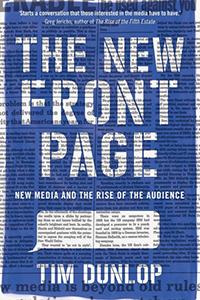
Stop Press: The Last Days of Newspapers, by Rachel Buchanan (Melbourne: Scribe, 2013)
The New Front Page: New Media and The Rise of the Audience, by Tim Dunlop (Melbourne: Scribe, 2013)
REVIEW: When Rachel Buchanan penned a commissioned article entitled “From the classroom to the scrap heap” for The Age last September, she railed against Australian journalism schools, in particular, against an alleged “lie” and “little integrity” of journalism education.
“Between 2002 and 2012, enrolments in journalism degrees almost doubled,” she noted about what was troubling her across the Tasman. “We now have the bizarre situation where there are more people studying journalism than there are working journalists.”
She concluded that journalism schools were creating false career hopes; Australia didn’t need any more journalists, but needed nurses and doctors, engineers and actuaries and so on.
“Poets, screenwriters, novelists, scribblers – we writers all need a day job now. You can’t eat integrity.”
This more than ruffled feathers among many journalism educators, it just about stirred a revolt. Many sided with Dr Johan Lidberg of Monash University, now one of the most innovative in Australia, who condemned her for “trashing journalism degrees”.
But Alex Wake, writing in The Conversation, was among the few who went beyond the reactions of outrage to her op-ed and went on to closely read Dr Buchanan’s recent book, Stop Press: The Last Days of Newspapers, and she concluded that The Age commentary “shamefully misrepresented” the true intention.
Saving journalism
She gave a measured response to Buchanan and offered a parallel final message that “it’s the journalism that matters most. We need to save journalism.”
In fact, Buchanan’s book is a beautifully crafted and robustly researched work and full of amusing and insightful anecdotes, even if the message for those in media, especially print, is depressing. The Australian Financial Review named it as one of the best books of 2013.
It is also a devastating revelation of how damaging the media out-sourcing has been to the newspaper industry in Australia and New Zealand, especially the latter where much of the contemporary “cheaper labour” regime has been refined.
She recalls her own experience working at Fairfax Editorial Services as an “outsourced, offshore sub” helping produce 11 dailies, 75 community papers and three national newspapers:
Although I tried to make light of it, the truth was that working in the hub was often brutally demanding, physically and intellectually … The mathematics of hubbing – fewer staff do more in remote locations – mean that every hub is the same. (p. 58)
New Zealand has been the target for restructuring the subediting industry with little connection to the local communities where newspapers are based; the Philippines for digital photos and phones; and India for advertising.
Yet the response to Buchanan’s bleak message this side of the Tasman has either been rather smug, or the book has simply been ignored with hardly any reviews in New Zealand media (unlike in Australia).
Critical thinkers
In her Age article, Buchanan was much kinder about the New Zealand relationship between journalism schools and the industry, taking at face value the claim by one journalism educator about “anyone who wants a job will get one”.
The reality is that Australian journalism schools are producing vastly more talented innovative and investigative journalists, critical thinkers who are challenging the mainstream and producing new media models or making their mark in the mainstream.
Also, journalism graduates end up in media-related careers and are more involved in debating the future trajectories of the industry in crisis. While in New Zealand, journalism schools are far more focused on fodder for replicating the local industry with little engagement for the journalism of change.
This is probably a factor on why many New Zealand journalism graduates head overseas for an offshore career – and even further education.
In Stop Press, Buchanan’s insights into the failing future of the print media industry are revealing, with a salutary examination of the fate of the The Age’s $220 million Tullamarine printing plant (opened in 2002 and due for closure by mid-2014) and the collapse of the New Zealand newsprint industry – and the destruction of so many livelihoods dependent on the newspaper industry:
Newspapers are ill. The printing trade is dying. Skills are vanishing. We are witnessing the death spiral of print. The age of industrial manufacturing of newspapers is over. Publishers are abandoning newsprint and and will swap the mighty web-offset presses for miniature digital ones. (p. 116)
But she also explores contrasting “downsized”, but hopeful, newspaper industry development options and acknowledges the phenomenal growth of newspapers in countries such as China, India and Indonesia.
Dramatic changes
Stop Press is the second in the three-volume Media Chronicles series produced by Scribe, four-times winner of the small publisher award in Australia.
“The series idea seemed natural to me when I saw the need for a number of first-person accounts about the dramatic changes underway in the mass media,” explains Scribe publisher Henry Rosenbloom.
Another Scribe author and innovative educator, Margaret Simons, director of Melbourne University’s Centre of Advanced Journalism, whose own books, Journalism at the Crossroads and What’s next in Journalism? (an edited collection of entrepreneurial journalist essays), predicated the series, says: “The new publications are having a significant impact, but the mainstream is also changing fast for other reasons.
“I remain dismayed by how conservative the mainstream can be when it comes to experimenting with the form and the method.”
 The first in the series was The New Front Page: New Media and the Rise of the Audience, by political blogging pioneer Dr Tim Dunlop, who tackles the reasons why the mainstream media industry in Australia and New Zealand have been so slow to embrace digital media and innovative “citizen journalism” approaches.
The first in the series was The New Front Page: New Media and the Rise of the Audience, by political blogging pioneer Dr Tim Dunlop, who tackles the reasons why the mainstream media industry in Australia and New Zealand have been so slow to embrace digital media and innovative “citizen journalism” approaches.
While Buchanan deals with the decline of the legacy newspaper gatekeepers as the central force of contemporary journalism and outsourcing as an industry, Dunlop examines how media can reclaim some integrity in the digital age and regain their relevance with the audience.
The disappearance of more serious content in favour of the celebrity gossip and other titillating information that click-throughs apparently show what we want is actually undermining the appeal of various news outlets, even among those who appear not to be accessing political journalism. (p. 221)
Bland defence
Dunlop observes that when you see an industry in as much commercial trouble as the media, it has to be concluded that it is doing something wrong. He dismisses the bland defence that the “media’s business model has been undermined by online technologies” as having missed the key point.
The old business model was based on a “massive disconnect” between the journalism and the people consuming it. And he rebukes the blind reliance on misleading online surveys.
Data is not destiny. If traditional media organisations are going to thrive, they are going to have to nurture new audiences into existence. They are going to have to gather knowledge of we, the people, not just mine information about us. (p. 223)
For the mainstream media to survive, he believes, it is going to have to radically change, not just tinker with converged media platforms. Media companies need to “reinvent their fundamental understanding of what it is they are doing and how to do it” while retaining their foundations as a Fourth Estate in democracy.
References
Buchanan, Rachel (2013, September 28). From the classroom to the scrapheap, The Age.
Lidberg, Johan (2013, October 4). Who says journalism degrees are a lie?, New Matilda.
Simons, Margaret (2012). Journalism at the Crossroads. Melbourne: Scribe.
Simons, Margaret (2013). What’s Next in Journalism?: New Media Entrepreneurs Tell Their Stories. Melbourne: Scribe.
Wake, Alex (2013, October 9). Stop Press: We need to save journalism, not newspapers, The Conversation.




